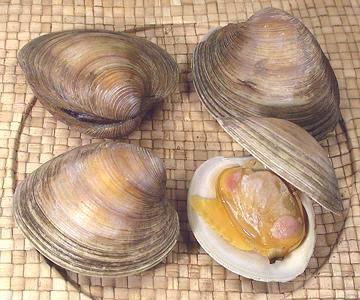 [Chowder Clams, Cherrystones, Topnecks, Middlenecks, Littlenecks,
Pastanecks, Countnecks; Mercenaria mercenaria]
[Chowder Clams, Cherrystones, Topnecks, Middlenecks, Littlenecks,
Pastanecks, Countnecks; Mercenaria mercenaria]
This common clam, native to the western North Atlantic, is found from Prince Edward Island, Canada all the way down to the Yucatán Peninsula, Mexico, but has traditionally been harvested mostly from Massachusetts to Virginia.
"Quahog" (pronounced coe-hog) is the proper name covering all sizes of hard clams, but in practice it is usually applied only to the largest ones. The names given above, from Chowder Clams to Countnecks, are size designations in descending order. The photo specimens were Cherrystones from Mexico, and were up to 3.4 inches the long way by 2.7 inches and 1.8 inches thick. 3 pounds yielded just over 6 ounces of meat (12.6%) so at US $2.99/# the meat was $23.73 per pound. Cherrystone meat is quite chewy cooked, so these are usually chopped up and/or given a long enough or hot enough cooking to tenderize them.
More on Bivalves.
Today most hard clams available commercially are farm raised, since wild stocks are seriously depleted and cannot support the market. On the East Coast of North America they are now farm raised from Massachusetts to Florida. Some are now also farmed on the West Coast of the US and Mexico, as well as in England and northern Europe.
And what's with those names? In the mid to late 1800's, clams from Little Neck Bay, Long Island, were the choice in the finest New York restaurants. The much larger Cherrystone clams were named for Cherrystone Creek, Virginia. These names became size standards for clams from anywhere, and the rest of the size names were made up.
These designations are approximate, as conventions differ from region to region, and have changed with marketing conditions over the years. Every source I have found gives different measurements than the others.
Clams are measured end to end, which means the straight line maximum length parallel to the hinge. There are strict minimum size limits for wild harvested clams, for instance: 2 inches in Maine and 1-1/2 inches in New Jersey. These size limits do not apply to farmed clams.
 I purchased these clams at a large Philippine market in Los Angeles
(Eagle Rock, actually). They came with an attached certification clearly
stating "Pasta Neck Clam", Farm raised and harvested in Hungars Creek,
Virginia, but they were larger than from my chart above, measuring
1-1/2 to 2 inches, 16 to the pound. Cost was 2016 US $3.99 / pound in
a 2.13 pound bag.
I purchased these clams at a large Philippine market in Los Angeles
(Eagle Rock, actually). They came with an attached certification clearly
stating "Pasta Neck Clam", Farm raised and harvested in Hungars Creek,
Virginia, but they were larger than from my chart above, measuring
1-1/2 to 2 inches, 16 to the pound. Cost was 2016 US $3.99 / pound in
a 2.13 pound bag.
These were harvested on 22 April 2016, purchased and steamed by me
on 4 May 2016. One was clearly dead (the open one in the photo), and
one did not open. The rest opened and were fine. They were just a bit
chewy, but quite edible as steamed. Yield for the steamed clam meat was
3-1/4 ounces, giving an edible cost of $39.99 / pound. Given that I can
buy frozen clam meat for about $3.75 / pound in the Asian markets, I
would use these for decorative purposes only, not for nutrition.